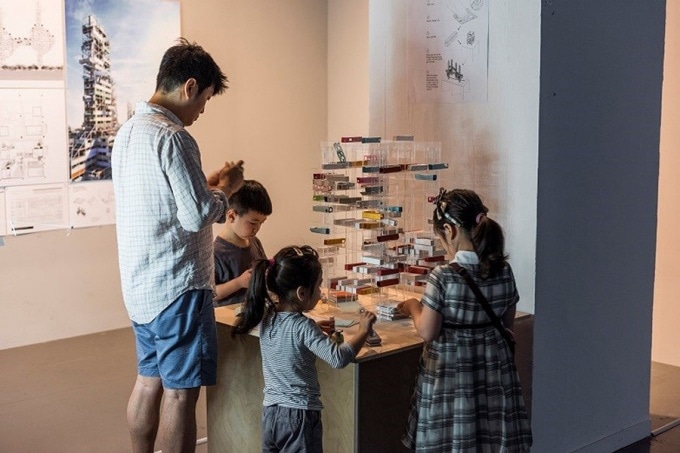Nov 8 2017
Visualize an apartment tower capable of expanding — and shrinking — to respond to the rapidly varying lifestyles. This very out-of-the-box smart building design has won UB architecture professor Jin Young Song the first place in a global competition for design in a “self-evolving city.”
 “Connected Living," Jin Young Song's winning design of interconnected towers with robotic, self-building intelligence, is on display in the SeMA (Seoul Museum of Art) through Nov. 12, alongside the competition’s other top finishers. (Credit: University at Buffalo)
“Connected Living," Jin Young Song's winning design of interconnected towers with robotic, self-building intelligence, is on display in the SeMA (Seoul Museum of Art) through Nov. 12, alongside the competition’s other top finishers. (Credit: University at Buffalo)
Song, assistant professor of architecture, came up with “Connected Living” after he had researched the 1960s Metabolism movement and emerging prefabrication and robotics in manufacturing. The proposal showcases a series of interconnected towers that self-construct and de-construct through embedded robots that react to their environment. The robots are incorporated to the building façade to alter, add, and remove prefabricated units when required, maximizing flexibility and aiding sustainable residential culture.
Organized by International Union of Architects (UIA) of Seoul 2017, the Self-Evolving City Competition, focused on themes of urban transition and designs for a changing world, similar to how a brain adjusts to a shifting environment. Using “schemes, cognitive maps and a model of mental states to represent the self,” designers across the world were asked to come up with designs that can measure and adapt to environmental and performative conditions.
“ndividual architecture of the aesthetic dimension disappears, and what remains is urban residence of the ethical dimension,” he wrote in a published article. “The necessity-based expansion and contraction of residential units happens midair, so that the discriminative hierarchy of the land, where value is created by money, disappears.
Gunsoo Shin , Architectural critic
“Connected Living” is being exhibited in the Seoul Museum of Art (SeMA) through November. 12, together with the competition’s other top finishers. At the museum, people will be able to fold papers and punch windows to create future apartments.
UB students and associates from Song’s firm, Dioinno Architecture, assisted in developing the museum exhibit. Members of the design team included Hashim Ajlouni (MArch ‘16), William Baptiste (MArch ‘18), Ning Ding (Architecture BS ‘18), Tino Goo (MArch ‘16), Euychan Jung (MArch ‘18), Laeyeon Kim (exchange student to UB), Seungjun Lee (BAED ‘19), David Hakcheol Seo (BS ‘18), Daniel Vrana (MArch ‘16) and Bonghwan Kim, a structure consultant with Skidmore Owings and Merrills LLP.
Last year Song also was awarded first place in the Laka Competition with his project “Snapping Façade,” created with the assistance of Jongmin Shim, UB assistant professor of civil, structural, and environmental engineering.